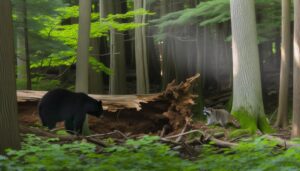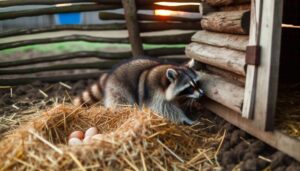Do Raccoons Eat Duck Eggs?
Yes, raccoons do eat duck eggs. As omnivorous mammals with opportunistic feeding habits, raccoons readily prey on duck eggs when opportunities arise.
Duck nests, especially those located on the ground, are particularly vulnerable to raccoon predation. Raccoons utilize their keen senses and dexterous paws to infiltrate nests and consume eggs, significantly impacting local avian populations.
Evidence of their presence includes distinctive paw prints and scattered eggshells near nest sites. Understanding the various signs of raccoon activity and the ecological impact on duck nesting success is vital.
Continue to explore preventive measures and detailed predator behavior for thorough strategies.
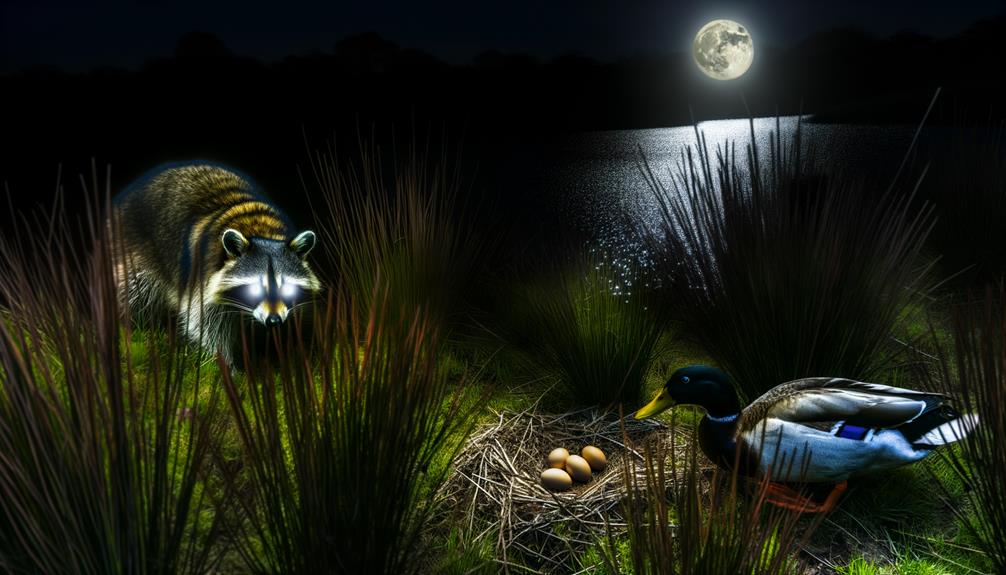
Key Takeaways
- Raccoons are omnivorous and readily eat duck eggs when they find them.
- Duck eggs are vulnerable, especially in ground nests where raccoons can easily access them.
- Raccoons use their keen senses and dexterous paws to locate and break into nests.
- Evidence of raccoon predation includes scattered eggshells and nighttime activity near nests.
- Protective measures like elevated nesting sites and predator guards can reduce raccoon access to duck eggs.
Raccoon Dietary Habits
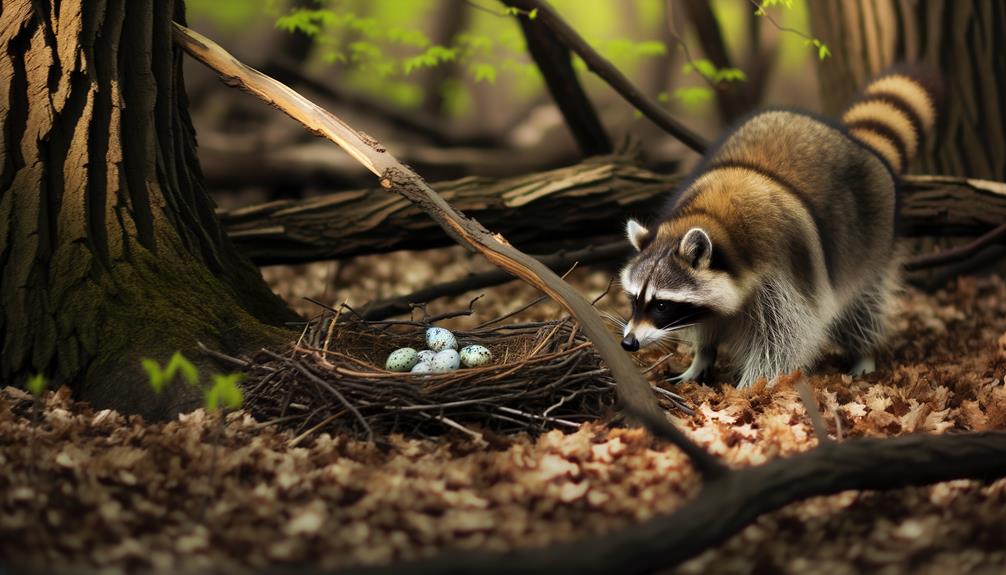
Raccoon dietary habits are characterized by their opportunistic and omnivorous nature, allowing them to consume a diverse range of food sources depending on availability. These adaptable mammals exhibit a diet that includes fruits, nuts, berries, insects, small vertebrates, and plant matter.
Raccoons are skilled foragers, often scouring urban environments for discarded human food waste. Seasonal variations influence their diet, with a preference for high-calorie foods in preparation for winter. Additionally, raccoons are known to exploit aquatic ecosystems, feeding on fish, amphibians, and crustaceans.
Their highly developed sense of touch and dexterous front paws enable them to investigate and manipulate various potential food items efficiently. This dietary flexibility is important for their survival in both wild and urban habitats.
Raccoons as Predators
Importantly, these omnivorous mammals also exhibit predatory behaviors, often targeting small animals and bird eggs as part of their diverse diet. Raccoons (Procyon lotor) possess keen senses and dexterous front paws, allowing them to hunt and forage with notable efficiency.
Their opportunistic feeding habits mean they will exploit available food sources, including amphibians, insects, crustaceans, and various small vertebrates. Raccoons are particularly adept at locating nests, where they consume eggs and juvenile birds.
This predatory behavior is facilitated by their nocturnal lifestyle, which provides cover and reduces competition from diurnal predators. Studies have shown that raccoons can have a substantial impact on local avian populations, particularly in environments where natural predators are scarce or human activities have disrupted ecological balances.
Duck Egg Vulnerability
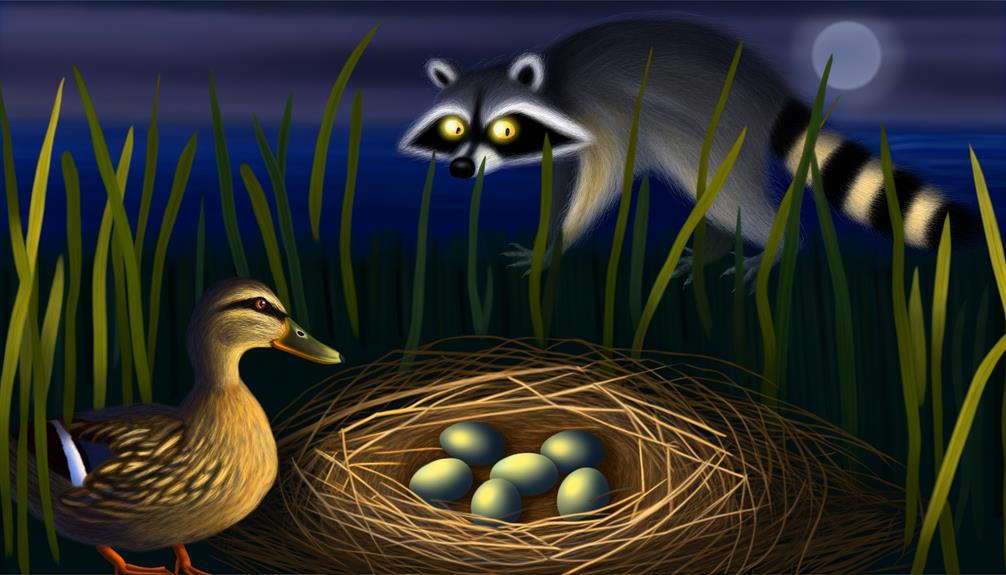
Duck eggs are particularly susceptible to predation due to several factors, including nesting locations and limited predator evasion techniques. Ducks often nest in ground-based locations, which can be easily accessed by raccoons.
Additionally, the absence of advanced defensive behaviors in ducks further compromises the safety of their eggs.
Nesting Locations and Safety
The vulnerability of duck eggs to predation is greatly influenced by the specific nesting locations chosen by ducks. Ducks typically select sites that offer both concealment and proximity to water sources. However, these locations can vary widely, ranging from dense vegetation to open areas near shorelines.
Dense vegetation provides cover but can also attract land predators like raccoons, who are skilled at maneuvering such environments. Conversely, open nesting sites may reduce concealment from aerial predators but increase visibility to terrestrial threats. The proximity to water is vital, as it offers an escape route for adult ducks, yet it can also be a pathway for predators.
Consequently, the selection of nesting sites is a pivotal factor in duck egg survival.
Predator Evasion Techniques
Utilizing a variety of adaptive behaviors, ducks employ several predator evasion techniques to enhance the survival prospects of their eggs. These strategies are essential in mitigating risks from predators such as raccoons.
Key techniques include:
- Nesting Concealment: Ducks often select nesting sites with dense vegetation or inaccessible locations to obscure the nest from potential predators.
- Decoy Tactics: Female ducks may feign injury to distract predators away from their eggs, a behavior known as the 'broken-wing act.'
- Nocturnal Nesting: Some species opt for nocturnal nesting activities to avoid diurnal predators.
- Synchronous Hatching: Coordinated hatching reduces the duration during which eggs are vulnerable, thereby minimizing exposure to predation.
These methods collectively enhance the likelihood of egg survival in the presence of raccoons.
Signs of Raccoon Presence
Identifying the presence of raccoons around duck nests involves examining specific indicators such as distinctive paw prints, remnants of scattered eggshells, and patterns of nocturnal activity.
These signs provide essential evidence that raccoons may be preying on duck eggs.
Analyzing these markers allows for a better understanding of raccoon behavior and their impact on local duck populations.
Paw Prints Identification
Recognizing paw prints is an essential method for determining the presence of raccoons around duck nests. Raccoon tracks are distinctive and can provide valuable clues.
Typically, raccoon paw prints exhibit the following characteristics:
- Size: Front paw prints are approximately 2 to 3 inches in length, while the hind paw prints measure around 3 to 4 inches.
- Shape: The prints show five long, slender toes with noticeable claw marks.
- Pattern: The tracks often appear in a diagonal walking pattern, indicating their characteristic gait.
- Location: Tracks are commonly found near water sources, muddy areas, and along paths leading to potential food sources, such as duck nests.
Scattered Eggshells Clues
Scattered eggshells around a duck nest can serve as a significant indicator of raccoon predation. Raccoons are known to be opportunistic feeders, and their feeding habits often involve breaking open eggs and consuming the contents while leaving behind fragmented shells.
These eggshells are typically found dispersed around the nesting area, displaying irregular, jagged edges resulting from the raccoons' strong, dexterous paws and sharp teeth. Unlike other predators that may carry eggs away from the nest, raccoons tend to consume them on the spot, leading to a localized distribution of shell fragments.
Examining the pattern and nature of these eggshell remnants can provide valuable insights into identifying raccoons as the primary culprits in duck egg predation.
Nighttime Activity Indicators
Raccoons are primarily nocturnal creatures, making their presence around duck nests most apparent through nighttime activity indicators. Recognizing these signs is essential for identifying potential threats to duck eggs.
Here are four key indicators:
- Tracks: Raccoon footprints are distinctive, with five toes and a heel pad, resembling miniature human hands.
- Scat: Raccoon droppings are typically tubular and may contain remnants of their varied diet, such as seeds or insect parts.
- Noise: Rustling sounds, chattering, or the noise of rummaging near nests can indicate raccoon activity.
- Disturbed Nests: Duck nests showing signs of disarray, such as scattered nesting materials or partially eaten eggs, often suggest raccoon interference.
Nesting Sites at Risk
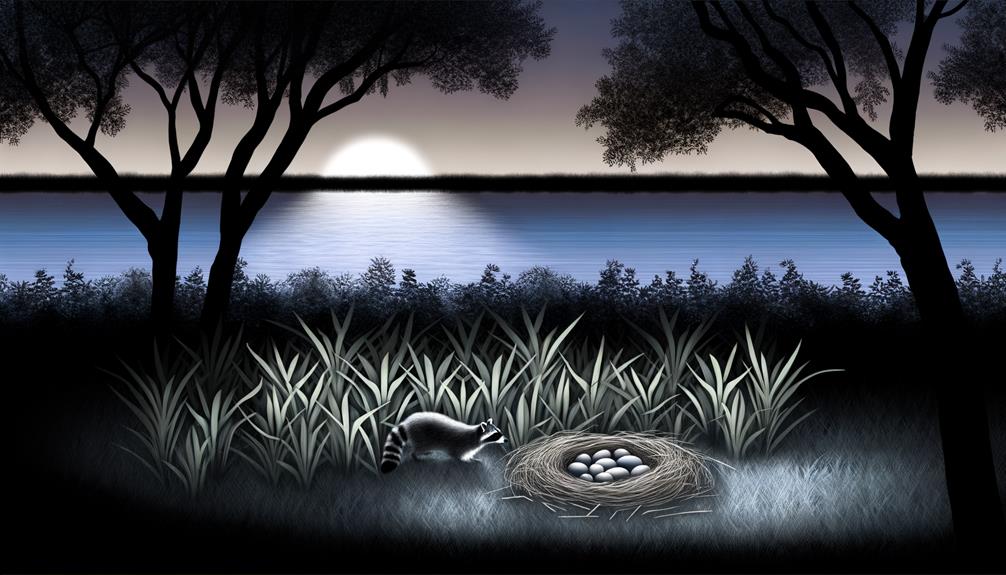
The presence of raccoons in nesting areas greatly increases the risk of predation on duck eggs, jeopardizing successful reproduction. Raccoons are opportunistic feeders with a keen sense of smell, enabling them to locate duck nests efficiently.
They typically target ground nests, making species that nest on the ground particularly vulnerable. The predation pressure from raccoons can lead to significant declines in duckling survival rates. Studies have shown that raccoons are responsible for a substantial percentage of egg loss in certain regions.
This predation not only affects individual nests but can also have broader ecological impacts, potentially altering local bird populations and dynamics. Understanding these risks is essential for developing effective conservation strategies.
Protective Measures
To mitigate the risk of raccoons preying on duck eggs, several protective measures can be implemented. Securing nesting areas with appropriate barriers, employing predator guards, and installing motion-activated lights are effective strategies supported by research.
These methods aim to create a safer environment for duck eggs by deterring raccoon activity through physical and sensory deterrents.
Secure Nesting Areas
Ensuring the security of nesting areas involves implementing multiple protective measures designed to deter predators and safeguard duck eggs. Effective strategies include:
- Elevated Nesting Sites: Position nests at elevated locations to make access challenging for ground-based predators, such as raccoons.
- Secure Enclosures: Utilize wire mesh or other sturdy materials to construct enclosures that prevent predators from reaching the nests.
- Natural Barriers: Incorporate dense vegetation or water barriers around nesting sites, which can serve as physical deterrents to predators.
- Regular Monitoring: Conduct frequent inspections of nesting areas to identify and address potential security breaches promptly.
These measures, when combined, create a robust defense system that significantly boosts the protection of duck eggs from predation.
Use Predator Guards
Implementing predator guards is a crucial measure in protecting duck eggs from predation by species such as raccoons. These devices serve as physical barriers, preventing raccoons from accessing nesting sites.
Common types include cone-shaped baffles and cylindrical guards, which are typically installed around the base of nesting platforms or trees. The design of these guards effectively obstructs raccoons' climbing abilities, thereby safeguarding the eggs.
Constructed from durable materials such as metal or heavy-duty plastic, predator guards are engineered to withstand environmental wear. Regular inspection and maintenance of these guards ensure their continued effectiveness.
Employing predator guards in conjunction with other protective strategies significantly reduces the risk of egg predation, promoting higher survival rates for duck populations.
Install Motion Lights
In addition to predator guards, installing motion-activated lights can serve as an effective deterrent against raccoons preying on duck eggs. These lights leverage raccoons' natural aversion to sudden illumination, making them an important tool in protective measures.
When considering motion lights, it is essential to evaluate their placement and functionality for optimum efficacy. Here are four key considerations:
- Sensor Range: Confirm the motion light has a sufficient detection range to cover the entire nesting area.
- Brightness: Opt for lights with high lumens to maximize the startling effect on raccoons.
- Weather Resistance: Select lights designed to withstand outdoor conditions to maintain functionality.
- Energy Source: Choose between solar-powered or battery-operated lights, depending on the specific environmental setting.
Alternative Predators

Aside from raccoons, a variety of other predators such as foxes, snakes, and birds of prey also pose significant threats to duck eggs.
Foxes are adept hunters, known for their ability to locate and raid nests, consuming both eggs and ducklings.
Snakes, particularly species like rat snakes, can infiltrate nests and consume multiple eggs in a single visit.
Birds of prey, including hawks and owls, may also target unprotected nests, snatching eggs or vulnerable ducklings.
Each predator employs unique strategies and possesses specialized adaptations that enable them to exploit duck nests effectively.
Understanding the range of potential threats is essential for developing all-encompassing strategies to protect duck eggs from predation, ensuring higher survival rates for duck populations.
Raccoon Deterrents
Effective raccoon deterrents are essential for safeguarding duck eggs from predation and ensuring higher survival rates. Implementing these measures can notably reduce the risk posed by raccoons.
Here are four scientifically-backed deterrents:
- Electric Fencing: Installing low-voltage electric fences around nesting areas creates a physical barrier that raccoons find unpleasant, thereby discouraging their approach.
- Motion-Activated Lights and Sprinklers: These devices startle raccoons with sudden light or water bursts, making the nesting site less attractive.
- Predator Scents: Utilizing commercially available scents mimicking larger predators can create an illusion of danger, deterring raccoons.
- Secure Nesting Boxes: Elevating and reinforcing nesting boxes with heavy-gauge wire mesh can prevent raccoons from accessing duck eggs.
Employing these methods can enhance the protection of duck eggs from raccoon predation.
Safe Nesting Practices
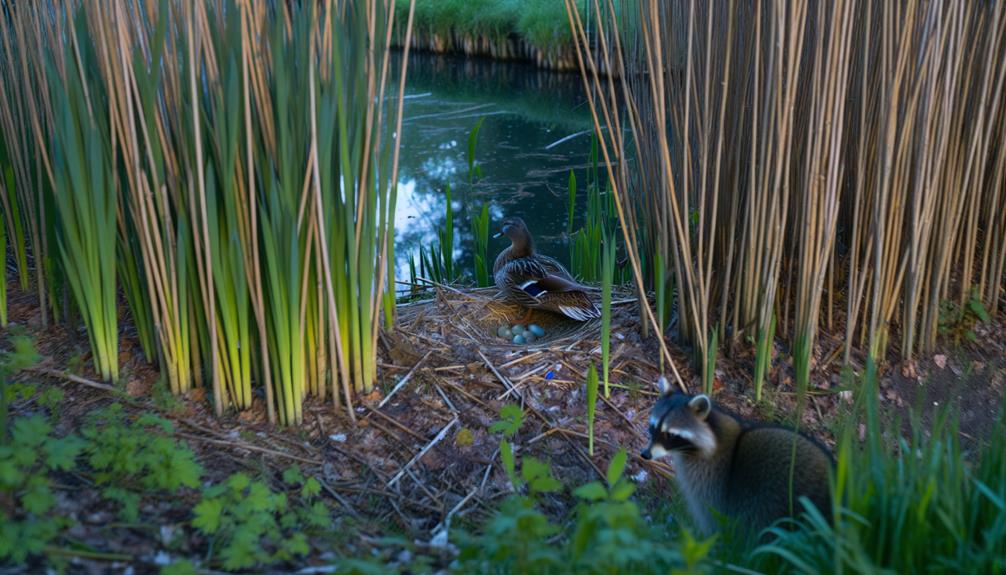
Implementing safe nesting practices is essential for minimizing the risk of predation and ensuring the successful hatching of duck eggs. Key strategies include selecting nesting sites that are elevated or surrounded by natural barriers, which can deter raccoons and other predators.
Utilizing nesting boxes with secure lids and small entry holes can provide additional protection. Additionally, surrounding the nesting area with wire mesh can create a physical barrier against intruders.
Vegetation management, such as maintaining thick underbrush, can also obscure nests from potential predators. It is important to avoid human scent near nesting sites, as this can attract predators.
Monitoring and Maintenance
Regular monitoring and maintenance of nesting sites are crucial for guaranteeing the ongoing safety and viability of duck eggs. This practice helps in early detection of potential threats, including predation by raccoons. Effective monitoring involves systematic observation and immediate response to any signs of disturbance.
Key maintenance activities include:
- Regular Inspections: Conduct frequent checks of nesting sites to identify any structural weaknesses or evidence of predators.
- Predator Deterrents: Implement and maintain deterrents such as fencing or predator guards around nests.
- Nest Hygiene: Ensure that nesting sites are clean and free from debris that might attract predators.
- Data Logging: Maintain detailed records of observations and interventions to track patterns and improve future protective measures.
This structured approach fosters a secure environment for duck eggs.
Conclusion
To conclude, raccoons, as omnivorous predators, pose a significant risk to duck eggs by taking advantage of weaknesses in nesting locations. Proof of their existence, along with the recognition of other predators, highlights the importance of efficient deterrents and secure nesting practices.
Diligent supervision and upkeep of nesting areas are essential. Hence, comprehending raccoon feeding patterns and behaviors is vital for safeguarding vulnerable avian populations, demonstrating that information is the cornerstone in preserving biodiversity.




